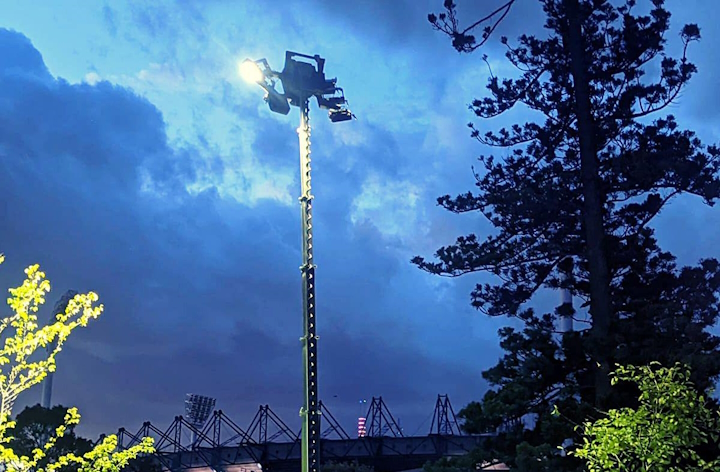
Are you a purchasing officer looking for an effective way to boost safety, productivity and aesthetics during your work projects? Lighting towers are the perfect solution! With their bright illumination, they can light up even the darkest of areas providing better visibility and reducing hazards. Its range of applications from mining, metro, solar and more means it is suitable for numerous scenarios. Depending on which project type you're undertaking, there are countless benefits associated with using lighting towers - from improved communication between staff members to increased security levels or savings in energy wastage. Keep reading to find out how these lightning towers can benefit different sectors as well as tips on making sure your next lighting tower investment is successful!
Choosing the right lighting tower largely depends on your specific project needs and circumstances. For instance, if your project involves nighttime operations in a remote location with no power supply, a diesel-powered lighting tower would be an ideal choice due to its self-sufficient nature. On the other hand, if you're managing an event in a suburban area and environmental impact is a concern, an LED or solar-powered lighting tower would be a more eco-friendly solution. It's also essential to consider the tower's light coverage and height, the durability of its design, and ease of transportation and setup. Each of these factors plays an integral role in determining the most suitable lighting tower for your project. Always remember, the right lighting tower not only illuminates your work area but also boosts safety, enhances productivity, and facilitates better communication among your team.
Custom-built lighting towers
Offer an additional level of flexibility and functionality by catering specifically to your unique project needs. These bespoke solutions can be designed and manufactured to accommodate specific light intensity requirements, heights, power types, and more. They can also incorporate additional features like remote control capabilities, weather-resistant materials, or specialized lighting for specific industries. One of the key benefits of custom-built lighting towers is their ability to provide optimal illumination tailored to the precise parameters of your project, thus ensuring maximum productivity, safety, and efficiency.
Can you upgrade old lighting towers?
Yes, upgrading old lighting towers is entirely possible and can be a cost-effective approach if your current towers are structurally sound but not meeting your project's lighting needs. This could involve replacing outdated lighting systems with newer, energy-efficient LED lights, or adding extra features like remote control capabilities for increased convenience. It's also possible to retrofit towers to accommodate solar power, if sustainable energy usage aligns with your project needs or company values. However, the feasibility and cost-effectiveness of an upgrade depend on the existing condition and age of the lighting towers. It's always advisable to consult with a lighting tower specialist to assess whether an upgrade is the right solution for your specific circumstances.
What is a lumen?
A lumen is a unit of measurement used to quantify the amount of visible light emitted by a source. It is a standard term in the field of lighting and is essential in evaluating the brightness of light bulbs. The higher the lumen rating, the brighter the light source is. Lumens are crucial in determining the appropriate lighting for specific spaces or tasks, enabling consumers to choose lighting solutions that deliver the right amount of illumination for their needs. It's always important to consider the lumen count, rather than the wattage when seeking energy-efficient lighting options.
Think of a lumen as a measure of how much light a flashlight or a light bulb can give off. If we imagine that light is like a bucket of water, a lumen would be like a cup of that water. The more cups (or lumens) a light source has, the brighter it is. So, a light bulb with lots of lumens is like a bucket filled with water, while a light bulb with fewer lumens is more like a half-filled bucket. The more lumens a light bulb has, the brighter the light it can provide.
To further illustrate the concept of lumens, let's compare it to a candle. A standard candle, also known as a candela, emits light with a luminous intensity of roughly one lumen in a particular direction. Therefore, one lumen can be considered approximately equal to the light output of a single candle. However, it's crucial to remember that this comparison is a rough approximation and actual light output may vary depending on factors such as the candle's size, the wick, and the type of wax used.
How many lumens do they produce
The lumen output of lighting towers can significantly vary depending on their specifications and design. However, to give you a rough idea, an average industrial lighting tower equipped with metal halide lamps can produce up to 440,000 lumens. On the other hand, LED-based lighting towers, which are known for their energy efficiency, can deliver a comparable light output, often ranging from 200,000 to 500,000 lumens. It's crucial to remember that these are just typical ranges and tailored solutions can result in different lumen outputs based on specific project needs. Always consult with a lighting tower specialist to determine the appropriate light intensity for your project.
How long do light towers last?
The lifespan of lighting towers can significantly vary depending on several factors such as their level of maintenance, the quality of components used, and the environmental conditions they are exposed to. On average, with proper care and regular maintenance, a well-constructed lighting tower can last up to 10 to 15 years. However, the lighting system itself may need to be either upgraded or replaced earlier, particularly if it's a traditional bulb system. LED systems, on the other hand, have a much longer lifespan, often exceeding 50,000 hours of use. It's recommended to regularly inspect your lighting towers to ensure they are in optimal working condition and to address any potential issues promptly.
Light tower servicing
Regular servicing and maintenance of lighting towers is crucial to ensure their optimal performance and longevity. This involves various checks and procedures such as inspecting the illuminating bulbs for any signs of wear and tear, checking the fuel level and refilling if necessary, and cleaning the lens and reflectors to maintain maximum light output. The structural integrity of the tower itself should also be assessed regularly, including the base, mast and outriggers, for any potential weaknesses or damages. Lastly, the tower's generator or power source should be serviced according to the manufacturer's guidelines, which may include changing the oil, replacing the air filter, or checking the battery. By adhering to a regular servicing schedule, you can prevent unexpected breakdowns and ensure your lighting tower remains in excellent working condition.





